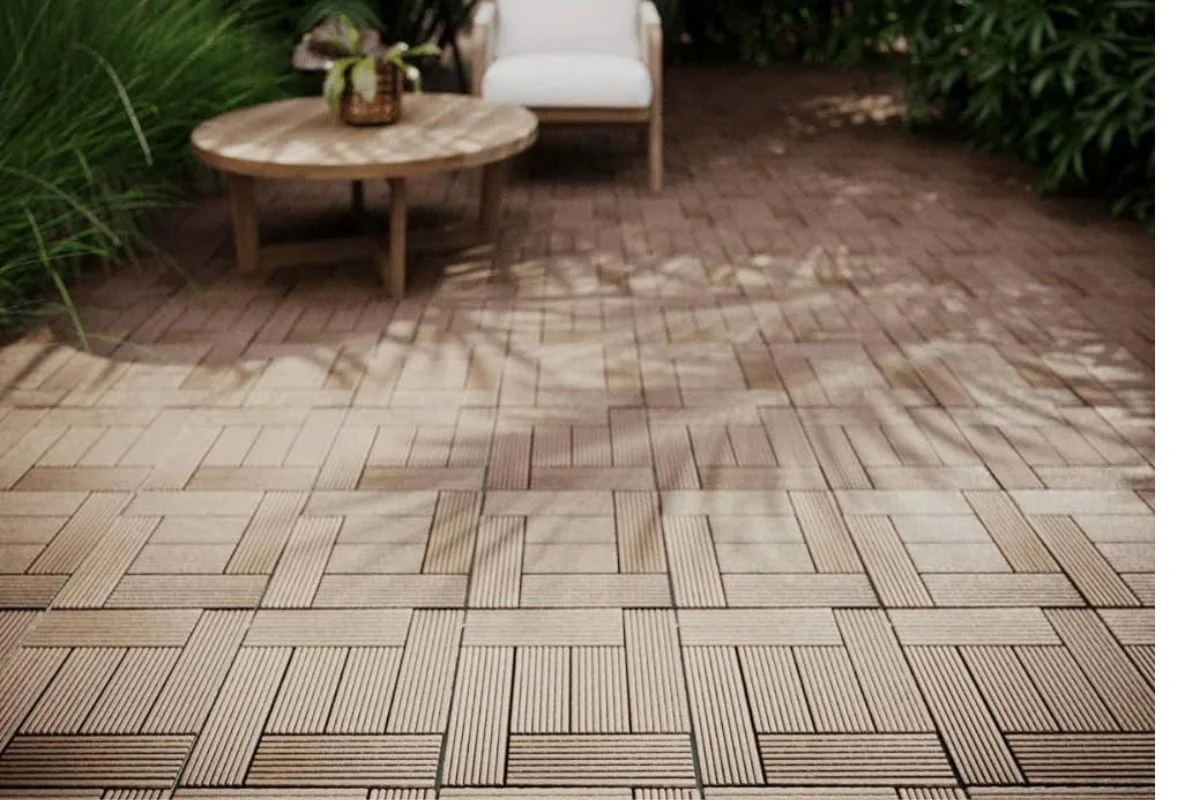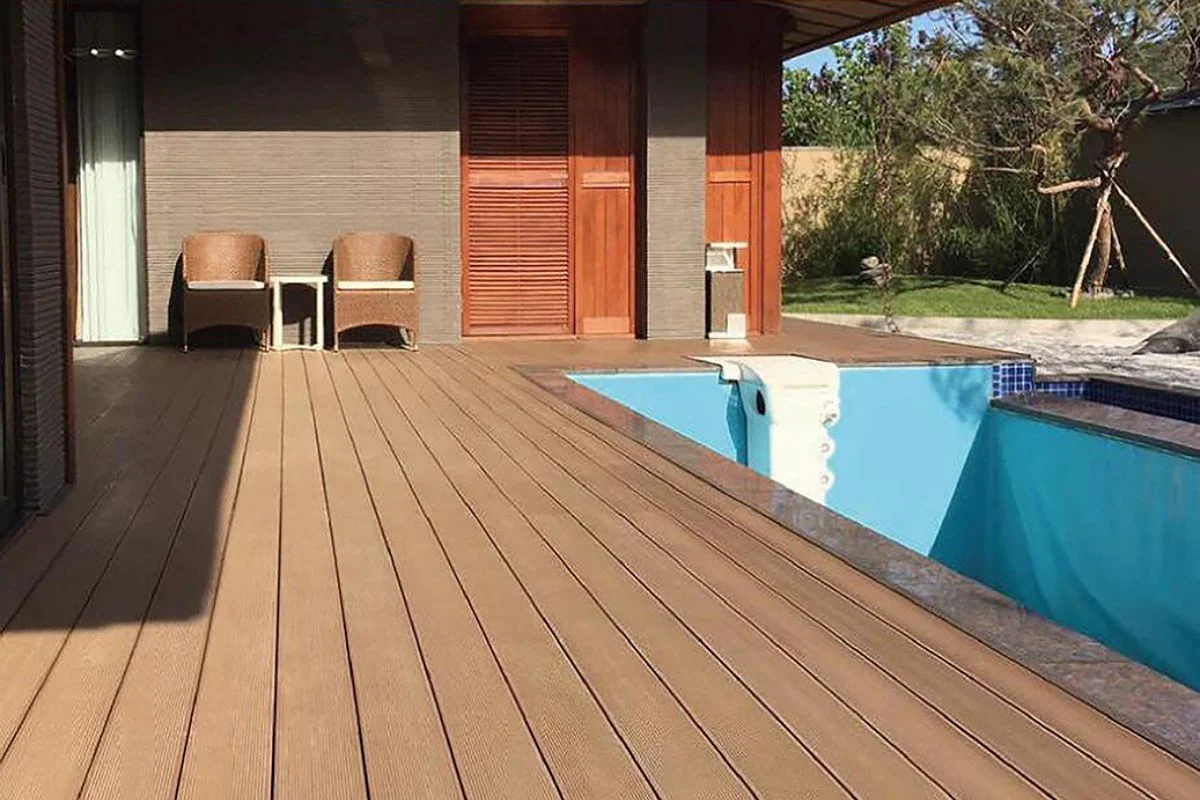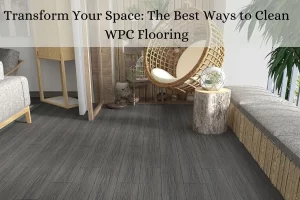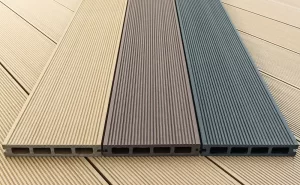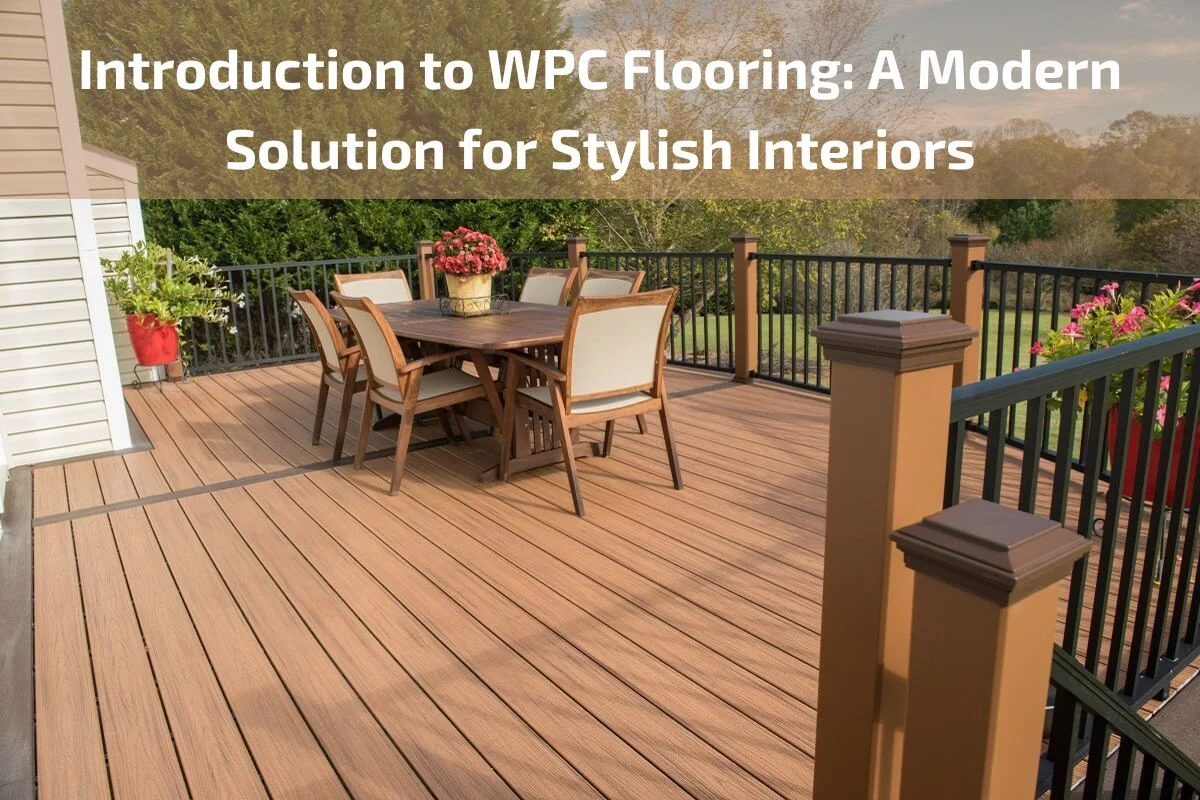
In the ever-evolving landscape of interior design, the quest for innovative flooring solutions that seamlessly blend style, durability, and sustainability has led to the rise of WPC (Wood Plastic Composite) flooring. As modern lifestyles demand flooring materials that not only enhance aesthetics but also offer practical benefits, WPC flooring emerges as a compelling choice for today’s stylish interiors.
WPC flooring represents a fusion of natural wood fibers and high-quality polymer resins, resulting in a versatile material that captures the timeless beauty of wood while delivering enhanced performance and longevity. With its unique composition and construction, WPC flooring offers a host of advantages that set it apart from traditional flooring options, making it a preferred choice for homeowners, designers, and architects alike.
What is WPC Flooring
WPC flooring stands for Wood Plastic Composite flooring. It is a modern flooring option that combines natural wood fibers and recycled plastic resins to create a durable and versatile material for use in residential and commercial spaces.
WPC flooring is engineered to mimic the look and feel of real wood while offering enhanced performance characteristics. It typically consists of several layers, including a rigid core made of a composite mixture of wood fibers and plastic resins, a decorative printed layer that replicates the appearance of wood grain or other natural materials, and a protective wear layer that provides durability and resistance to scratches, stains, and moisture.
One of the key benefits of WPC flooring is its waterproof nature, making it suitable for use in areas prone to moisture, such as kitchens, bathrooms, and basements. It is also known for its stability, with minimal expansion and contraction in response to changes in temperature and humidity, making it an ideal choice for installations over concrete or in regions with fluctuating climate conditions.
WPC flooring is available in a wide range of colors, patterns, and textures, allowing for versatile design options to suit various interior styles and preferences. It is often installed using a floating click-lock system or glued directly to the subfloor, offering ease of installation for both professionals and DIY enthusiasts.
Overall, WPC flooring offers the beauty of natural wood with the durability, water resistance, and ease of maintenance of modern composite materials, making it a popular choice for homeowners and designers seeking a stylish and practical flooring solution.
Brief overview of WPC flooring
WPC flooring, short for Wood Plastic Composite flooring, is a modern and innovative flooring option that blends natural wood fibers with recycled plastic resins to create a durable and versatile material. It is designed to mimic the look and feel of real wood while offering enhanced performance characteristics.
WPC flooring typically consists of multiple layers, including a rigid core made of a composite mixture of wood fibers and plastic resins, a decorative printed layer that replicates the appearance of wood grain or other natural materials, and a protective wear layer that provides durability and resistance to scratches, stains, and moisture.
One of the primary advantages of WPC flooring is its waterproof nature, making it suitable for use in areas prone to moisture, such as kitchens, bathrooms, and basements. It is also known for its stability, with minimal expansion and contraction in response to changes in temperature and humidity, making it an ideal choice for installations over concrete or in regions with fluctuating climate conditions.
WPC flooring comes in a wide range of colors, patterns, and textures, offering versatility in design options to suit various interior styles and preferences. It can be installed using a floating click-lock system or glued directly to the subfloor, providing ease of installation for both professionals and DIY enthusiasts.
Overall, WPC flooring offers the beauty of natural wood with the durability, water resistance, and ease of maintenance of modern composite materials, making it a popular choice for homeowners and designers seeking a stylish and practical flooring solution for their spaces.
Definition and composition of WPC flooring
WPC flooring, short for Wood Plastic Composite flooring, is a type of engineered flooring material composed of a mixture of wood fibers and plastic polymers. This composite blend typically includes wood flour, thermoplastics such as polyethylene or polyvinyl chloride (PVC), and additives to enhance performance and durability.
The composition of WPC flooring can vary depending on the manufacturer and specific product formulation, but it generally consists of the following components:
Wood Fibers: WPC flooring incorporates wood fibers derived from various sources, including hardwoods, softwoods, and reclaimed wood materials. These wood fibers provide natural aesthetics and contribute to the overall strength and stability of the composite material.
Plastic Polymers: The wood fibers are combined with plastic polymers, such as polyethylene (PE) or polyvinyl chloride (PVC), to create a durable and weather-resistant material. The plastic polymers act as a binding agent, holding the wood fibers together and providing protection against moisture, rot, and decay.
Additives: Various additives may be included in the WPC formulation to enhance specific properties of the flooring material. These additives can include UV stabilizers to protect against fading, anti-microbial agents to inhibit mold and mildew growth, and fire retardants to improve fire resistance.
Stabilizers and Fillers: Stabilizers and fillers may also be added to the WPC mixture to improve dimensional stability, reduce shrinkage and expansion, and enhance overall performance. These additives help to maintain the structural integrity of the flooring material and ensure long-term durability.
Importance of WPC flooring in interior design
WPC flooring holds significant importance in interior design for several reasons:
Versatility: WPC flooring offers a wide range of design options, including realistic wood grain patterns, stone or tile looks, and various colors and textures. This versatility allows designers to achieve diverse aesthetic goals and match the flooring to the overall style and theme of the space.
Durability: WPC flooring is engineered to be highly durable and resistant to wear, scratches, stains, and moisture. This durability makes it suitable for high-traffic areas such as kitchens, bathrooms, and commercial spaces, where traditional wood or laminate flooring may be prone to damage.
Water Resistance: One of the key benefits of WPC flooring is its waterproof nature, which makes it ideal for areas with high humidity or moisture exposure. Its ability to resist water damage and swelling makes it a practical choice for bathrooms, basements, and other moisture-prone areas where traditional hardwood flooring may not be suitable.
Easy Maintenance: WPC flooring is easy to clean and maintain, requiring only regular sweeping and occasional mopping to keep it looking its best. Its protective wear layer helps to prevent stains and spills from penetrating the surface, making it an ideal choice for busy households and commercial settings where cleanliness is a priority.
Comfort and Underfoot Warmth: WPC flooring offers a comfortable underfoot feel and provides insulation against cold temperatures, making it a cozy and inviting flooring option for residential spaces. Its cushioned surface also reduces noise transmission, creating a quieter and more peaceful indoor environment.
Installation Flexibility: WPC flooring can be installed using a variety of methods, including floating, glue-down, or click-lock systems. This flexibility allows for easy installation over different types of subfloors and existing flooring materials, making it a versatile choice for renovation projects.
Environmental Considerations: Many WPC flooring products are made from recycled materials and are recyclable themselves, making them a sustainable choice for eco-conscious consumers. Additionally, the long lifespan of WPC flooring reduces the need for frequent replacements, further minimizing environmental impact.
Benefits of WPC Flooring
WPC (Wood Plastic Composite) flooring offers a multitude of benefits that make it a popular choice for both residential and commercial spaces. Here are some key advantages of WPC flooring:
Durability: WPC flooring is highly durable and resistant to wear, scratches, stains, and impacts. Its robust construction makes it suitable for high-traffic areas, providing long-lasting performance and maintaining its appearance even in busy households or commercial settings.
Water Resistance: One of the primary benefits of WPC flooring is its waterproof nature. Unlike traditional hardwood or laminate flooring, WPC flooring can withstand moisture without warping, swelling, or deteriorating. This makes it an ideal choice for areas prone to spills, such as kitchens, bathrooms, and basements.
Low Maintenance: WPC flooring is easy to clean and maintain, requiring only regular sweeping and occasional mopping to keep it looking its best. Its protective wear layer helps to prevent stains and spills from penetrating the surface, reducing the need for intensive cleaning or refinishing.
Comfortable Underfoot: WPC flooring offers a comfortable and cushioned feel underfoot, making it pleasant to walk on for extended periods. Its softness and warmth provide insulation against cold temperatures, enhancing comfort and coziness in residential spaces.
Versatile Design Options: WPC flooring comes in a wide range of colors, patterns, and textures, allowing for versatile design options to suit various interior styles and preferences. Whether you prefer the look of wood, stone, or tile, there is a WPC flooring option to match your aesthetic vision.
Easy Installation: WPC flooring is designed for easy installation, with options for floating, glue-down, or click-lock installation methods. This makes it a convenient choice for DIY enthusiasts or professional installers, saving time and effort during the installation process.
Environmental Considerations: Many WPC flooring products are made from recycled materials and are recyclable themselves, making them a sustainable choice for eco-conscious consumers. Additionally, the long lifespan of WPC flooring reduces the need for frequent replacements, further minimizing environmental impact.
Maintenance and Care of WPC Flooring
Maintaining and caring for WPC (Wood Plastic Composite) flooring is relatively easy and straightforward, thanks to its durable and resilient nature. Here are some tips to help you keep your WPC flooring looking its best:
Regular Cleaning: Sweep or vacuum your WPC flooring regularly to remove dust, dirt, and debris. This prevents particles from scratching the surface and helps maintain its appearance.
Damp Mopping: For deeper cleaning, use a damp mop with a mild detergent solution or WPC-specific floor cleaner. Avoid using abrasive cleaners or harsh chemicals that may damage the surface of the flooring.
Immediate Spill Cleanup: Wipe up spills and stains promptly using a clean, damp cloth or mop. Avoid allowing liquids to sit on the floor for an extended period, as this can cause staining or damage to the protective wear layer.
Avoid Excessive Water: While WPC flooring is waterproof, it’s still advisable to minimize exposure to standing water or excessive moisture. Wipe up spills immediately and use mats or rugs in areas prone to moisture, such as entryways or kitchens.
Protective Pads: Use felt pads or furniture coasters under heavy furniture legs to prevent scratches and indentations on the WPC flooring surface. Avoid dragging or sliding heavy objects across the floor to prevent damage.
Avoid Sharp Objects: Take care to avoid dropping or dragging sharp objects across the WPC flooring, as this can cause scratches or gouges. Use furniture sliders when moving heavy items to prevent damage to the flooring surface.
Periodic Maintenance: While WPC flooring is low-maintenance, it’s a good idea to periodically inspect the flooring for any signs of wear, damage, or issues. Address any problems promptly to prevent them from worsening over time.
Avoid Direct Sunlight: Excessive exposure to direct sunlight can cause fading or discoloration of WPC flooring over time. Use blinds, curtains, or UV-protective window films to minimize sun exposure and protect the flooring from UV damage.
Avoid Harsh Chemicals: Avoid using harsh chemicals, bleach, or abrasive cleaners on WPC flooring, as these can damage the surface and compromise its appearance. Stick to mild detergents or WPC-specific cleaning products for best results.
Follow Manufacturer’s Guidelines: Always follow the manufacturer’s guidelines and recommendations for cleaning, maintenance, and care of your WPC flooring. This ensures that you’re using the appropriate products and methods to preserve the integrity of the flooring surface.
Conclusion
In conclusion, maintaining and caring for WPC (Wood Plastic Composite) flooring is essential for preserving its durability, appearance, and longevity. By following simple maintenance routines, such as regular cleaning, prompt spill cleanup, and avoiding harsh chemicals and sharp objects, you can keep your WPC flooring looking its best for years to come.

